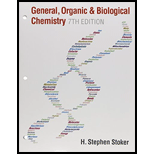
Concept explainers
Interpretation:
Half-life of the highest-atomic-numbered element 118 that is laboratory produced is measured in which unit has to be chosen from the given options.
Concept Introduction:
Radioactive nuclides undergo disintegration by emission of radiation. All the radioactive nuclide do not undergo the decay at a same rate. Some decay rapidly and others decay very slowly. The nuclear stability can be quantitatively expressed by using the half-life.
Radioactive decay happens naturally. This can also be done artificially in the laboratory by means of bombardment reaction.
Trending nowThis is a popular solution!

Chapter 11 Solutions
Bundle: General, Organic, and Biological Chemistry, 7th + OWLv2 Quick Prep for General Chemistry, 4 terms (24 months) Printed Access Card
- Potassium-44 decays by beta emission with a half-life of 22 minutes. A 125mg sample of the isotope is allowed to decay for 88 minutes. What mass of K-44 in mg remains in the sample after the 88 minutes? a. 7.81mg b. 15.6mg c. 31.5mg d. 62.5mg e. no correct responsearrow_forwardIntercomverting Iodine-125 is radioactive and has a half life of 60.25 days. How much of a 5.60 mg sample would be left after 88.1 days? Round your answer to 2 significant digits. Also, be sure your answer has a unit symbol. Explanation Check O 2021 McGraw-Hill Education. All Rights Reserved Terms of Use Privacy Ac MAY 10 Warrow_forwardThe decay constant for 32P is 4.85 x 10 ?d-. What is the half-life, in days, for the negatron decay of P? ORespond with the correct number of significant figures in scientific notation (Use E notation and only 1 digit before decimal e.g. 2.5e5 for 2.5 x 10) Type your responsearrow_forward
- Question 45 f the half life of P-32 is 14 days, how many grams will remain after 42 days if we start with a 100.0 gram sample? A) 50.00 grams B) 25.00 grams C 12.50 grams D 6.250 grams esc -> %23 % & Σarrow_forwardlodine-123 has a half life of 13 hours. How many hours are required for 95% of an l-123 sample to decay? hours Check Reuse Embed H5Parrow_forwardIodine-131 is administered orally in the form of NaI(aq) as a treatment for thyroid cancer. The half-life of iodine-131 is 8.04 days. If you begin with 53.0 mg of this isotope, what mass remains after 18.8 days have passed? mg Submit Answer Try Another Version 4 item attempts remainingarrow_forward
- Problem 1. It takes 5.2 min for a 1.000 - g sample of 210Fr to decay to 0.250 g. What is the half-life of 210Fr? Problem 2. How much time is required for a 6.25 - mg sample of "Cr to decay to 0.75mg if it has a half-life of 27.8 days?arrow_forwardQuestion 30 A certain radioactive isotope has a half life of 17.9 years. What percent of a sample remains after 87.5 years? Report your answer to one decimal place. Do not input a unit. Click Submit to complete this assessmentarrow_forwardSW Science 10 Unit 5 Radioactive Decay Worksheet Name:asmin laward th Student #: 5.2.1 Radioactive Decay - Half-Life 1. Complete the following table by shading in the appropriate number of squares or calculating the amount of parent material left or decay product formed. Amount % Decay Product FORMED % Parent Radioactive Mass (g) Fraction of Parent Material Material Lefe Material LEFT original sample 100g 100% 0% after 1 half-life 50g 50% after 2 half-lives 25g 12.5% after 3 half-lives 93.75% after 4 half-lives 2. Use the graph on the following page to plot the results of the table in question #1. NOTE: All Radioactive Decay graphs will have a similar shape.arrow_forward
- Cesium-137 is part of the nuclear waste produced by uranium-235 fission. The half-life of cesium-137 is 30.2 years. How much time is required for the activity of a sample of cesium-137 to fall to 26.0 percent of its original value? yrs Submit Answer Try Another Version 3 item attempts remainingarrow_forwardMacmillan Learning The half-lives of different medical radioisotopes are given in the table. If the initial amount of iodine-131 is 32 mCi, how much iodine-131 is left in the body after 24 days? O E Radioisotope arsenic-74 iodine-131 phosphorus-32 chromium-51 iodine-131 remaining: M Half-life (days) 8 X To login, enter your full email address and email password. For Example: Students: user@ut.utm.ed tm odwy mCi 9:37 PM 11/29/2022arrow_forwardHydrogen-3 is radioactive and has a half life of 12.3 years. What percentage of a sample would be left after 13.0 years? Round your answer to 2 significant digits. 20 Explanation Check O 2021 McGraw-Hill Education. All Rights Reserved. Tems of Use Priv MAY 10arrow_forward
 General, Organic, and Biological ChemistryChemistryISBN:9781285853918Author:H. Stephen StokerPublisher:Cengage Learning
General, Organic, and Biological ChemistryChemistryISBN:9781285853918Author:H. Stephen StokerPublisher:Cengage Learning
